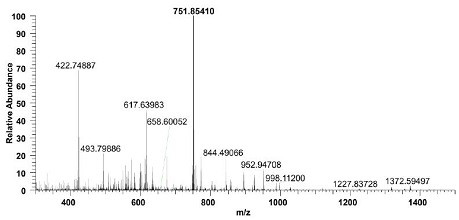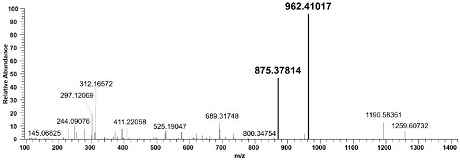A liquid chromatography-tandem mass spectrometry method for the detection of Apis mellifera mrjp1 and its application in identifying the authenticity of Apis mellifera honey
A technology of tandem mass spectrometry and liquid chromatography, which is applied in the field of food testing, can solve problems such as undeveloped identification methods for big bee honey, and achieve the effects of strong characteristics, good accuracy and precision, and high sensitivity
- Summary
- Abstract
- Description
- Claims
- Application Information
AI Technical Summary
Problems solved by technology
Method used
Image
Examples
Embodiment 1
[0037] Example 1 Excavation of MRJP1 characteristic peptides in the honey of Apis mellifera
[0038] Solution preparation:
[0039] 1. Solution preparation
[0040] 40 mM NH 4 HCO 3 Solution: weigh 0.316 g NH 4 HCO 3 , dilute to 100 mL with ultrapure water, and store in a 4°C refrigerator until use.
[0041] 100 mM DTT solution: weigh 0.308 g of DTT, add 40 mM NH 4 HCO 3 The solution was dissolved, mixed evenly and adjusted to 20mL, and stored in a -20°C refrigerator until use.
[0042] 100 mM IAA solution: Weigh 0.39 g of IAA, add 40 mM NH 4 HCO 3 The solution was fixed to 20 mL, and stored in a -20°C refrigerator until use.
[0043] 2. Weigh the honey and PBS solution according to the ratio of 1:1, vortex fully, centrifuge at 4°C for 20 min, and collect the supernatant;
[0044] 3. Take 100 μL supernatant and add 400 μL 40 mM NH 4 HCO 3 The solution was vortexed and mixed with it, and 50 μL of 100 mM DTT solution was added. After fully vortexed and mixed, it was...
Embodiment 2
[0055] Example 2 The establishment and detection method of the characteristic peptide segment of MRJP1 in bee honey
[0056] 1. All the characteristic peptides screened out in Example 1 are verified on the NCBI and Uniprot websites, and the characteristic peptides that only exist in the large bee MRJP1 are screened, and the mass spectrometry data generated in Example 1 is checked, and the response is selected The characteristic peptide with high concentration and no influence of other substances is the final characteristic peptide, ie ENAILSGEYDYTK.
[0057] 2. Synthesize the characteristic peptide segment ENAILSGEYDYTK and the stable isotope internal standard (IS) peptide segment ENAILSGEYDYTK*, K* means that all Cs in arginine are replaced by 13 C, all N replacements are 15 N, with a purity of over 98%, was stored at -20°C for future use.
[0058] 3. Drawing of Standard Curve
[0059] A series of characteristic peptide standards (1 ng / mL, 3 ng / mL, 5 ng / mL, 10 ng / mL, 20 ...
Embodiment 3
[0070]Example 3 Practical Application of MRJP1 Characteristic Peptides in Big Bee Honey
[0071] 1. Purchase samples of honey made by Italian bees (acacia honey, linden honey and wattle honey), soil honey (honey made by Apis mellifera), large bees and small bees from the regular market for actual sample testing.
[0072] 2. Detection of 6 kinds of honey samples
[0073] (1) Weigh the same amount of different honeys into centrifuge tubes, add PBS solution at a ratio of 1:1, vortex fully, centrifuge at 4°C for 20 min, and collect the supernatant;
[0074] (2) Take 100 μL supernatant and add 400 μL 40 mM NH 4 HCO 3 The solution was vortexed and mixed with it, and 50 μL of 100 mM DTT solution was added. After fully vortexed and mixed, it was reacted at room temperature for 60 min, and then 250 μL of 100 mM IAA solution was added to react in the dark at room temperature for 60 min;
[0075] (3) Add 2 μg excess trypsin to the 6 final solutions obtained in (2), and digest overnigh...
PUM
 Login to View More
Login to View More Abstract
Description
Claims
Application Information
 Login to View More
Login to View More - R&D
- Intellectual Property
- Life Sciences
- Materials
- Tech Scout
- Unparalleled Data Quality
- Higher Quality Content
- 60% Fewer Hallucinations
Browse by: Latest US Patents, China's latest patents, Technical Efficacy Thesaurus, Application Domain, Technology Topic, Popular Technical Reports.
© 2025 PatSnap. All rights reserved.Legal|Privacy policy|Modern Slavery Act Transparency Statement|Sitemap|About US| Contact US: help@patsnap.com



